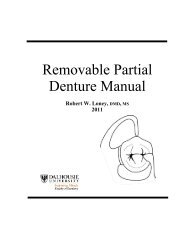Manuals_files/CD Manual 12.pdf - Removable Prosthodontics
Manuals_files/CD Manual 12.pdf - Removable Prosthodontics
Manuals_files/CD Manual 12.pdf - Removable Prosthodontics
You also want an ePaper? Increase the reach of your titles
YUMPU automatically turns print PDFs into web optimized ePapers that Google loves.
Preliminary Edemtulous Impressions - 7<br />
Preliminary Edentulous Impressions<br />
In order to make accurate edentulous impressions for the purpose of making dentures, a<br />
custom tray is required to more accurately adapt to the patient’s mouth. In the reference to<br />
complete dentures, it is particularly importantly to accurately capture the vestibular tissue<br />
anatomy, in order to create an effective seal for retention. Stock trays can result in distortion<br />
and shortening of the final denture flange. Custom trays are most easily made on accurate<br />
diagnostic casts made from preliminary impressions using an irreversible hydrocolloid<br />
(alginate) syringe technique. The use of the syringe technique ensures that alginate captures<br />
critical anatomy that is sometimes missed using a simple tray technique.<br />
The use of border molding in conjunction with the custom tray helps prevent distortion of<br />
the movable vestibular tissues. Displacement of these tissues could lead to dislodgment of the<br />
dentures during functional movements of muscles and frenal attachments, which could cause<br />
unseating of the denture.<br />
Irreversible Hydrocolloid Storage<br />
1. Pre-weighed pouches make dispensing easier, and minimizes contamination<br />
2. Store bulk material in airtight containers, store in cool dry containers<br />
3. Alginate deteriorates if stored above 54°C, or with repeated openings<br />
4. Deterioration results in thin mixtures, reduced strength, permanent deformation<br />
Tray Selection<br />
1. Select a tray with 5 mm of clearance with soft tissues – alginate requires bulk for<br />
accuracy, strength and stability.<br />
2. Maxillary trays should extend from the labial vestibule to slightly beyond the<br />
vibrating line. Mandibular trays should cover the retromolar pads.<br />
3. Sto-K trays or equivalent edentulous trays give the best results, but stock dentate trays<br />
can be used (distortion, overextensions are more common with dentate trays).<br />
4. Trays can be modified with compound to extend the tray if desired.<br />
Irreversible Hydrocolloid Syringe Technique<br />
Using a syringe to make preliminary impressions helps to register critical anatomy, which<br />
can be otherwise missed. In particular, these areas are captured more easily with a syringe<br />
technique:<br />
- Retromylohyoid area<br />
- Hamular notches<br />
- Retrozygomal area















